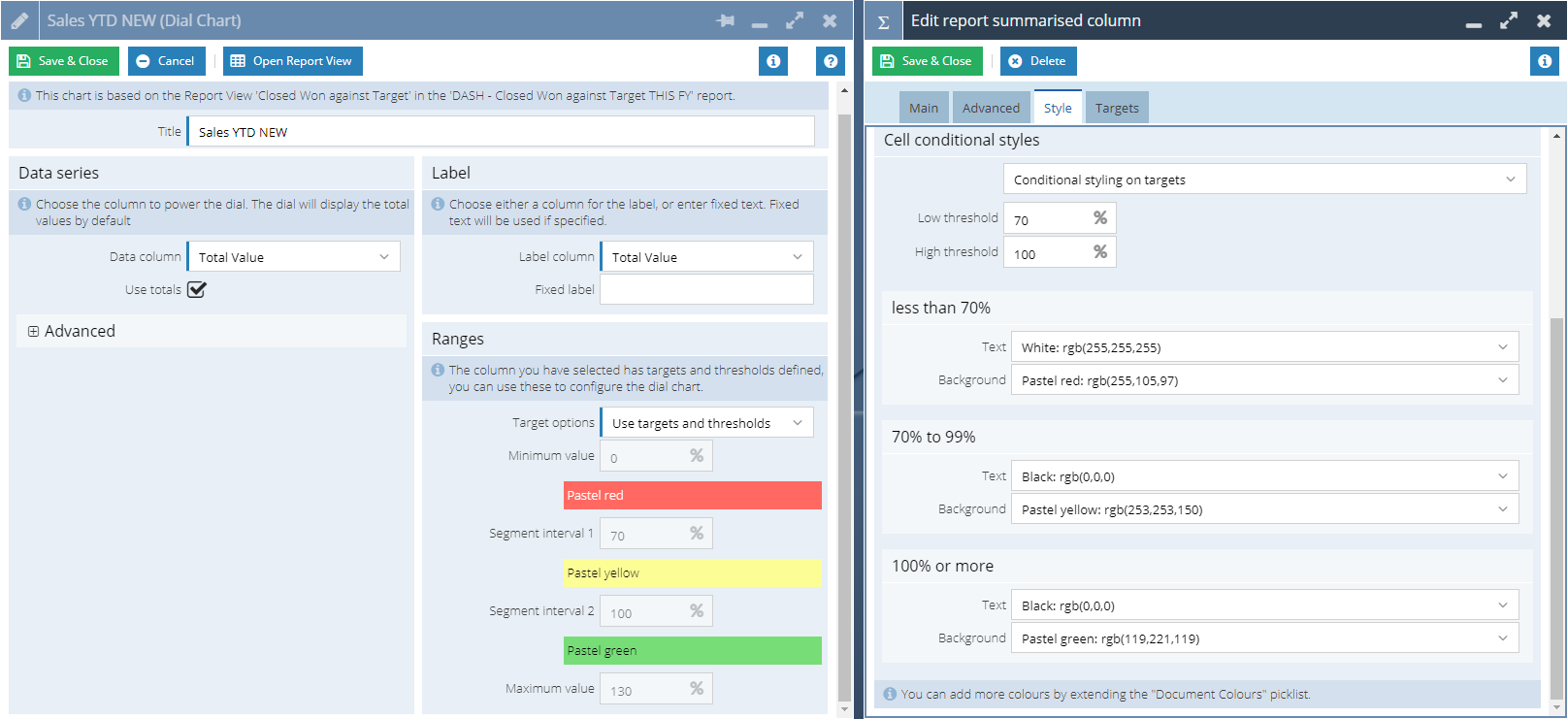Knowledgebase articles
- Welcome to the Knowledge Base
- Introduction
- Training
- Getting Started
- Preferences
- Activities
- Cases
- Importing Data
- Leads
- Marketing
- Introduction to Marketing
- Marketing Campaigns
- Mailing Lists
- Products
- Mailshots
- Upload Library
- Templates
- Event Management
- Compliance Records
- Force24
- Spotler Integration
- What is Spotler?
- Navigating your Spotler homepage
- GatorMail
- GatorLeads / Web Insights
- Tracking Code
- Setting up the Plugin
- Viewing Web Insights Data on your Form Layouts
- Domain Names and Online Activities
- Reporting incorrect Leads created through Web Insights
- Reporting on Web Insights data
- Using UTM Values
- Why aren’t Online Activities being created in the database?
- Why is GatorLeads recording online activities in a foreign language?
- GatorSurvey
- GatorWorkflow
- GatorPopup
- Opportunities
- Projects
- Integrations
- Mapping
- Electronic Signing Tools
- Creditsafe Integration
- Zapier
- Introduction to Zapier
- Available Triggers and Actions
- Linking your Workbooks Account to Zapier
- Setting up Zaps
- Posted Invoices to Xero Invoices
- Xero payments to Workbooks Tasks
- New Case to Google Drive folder
- New Case to Basecamp Project
- New Workbooks Case to JIRA Ticket
- Jira Issue to new Case
- 123FormBuilder Form Entry to Case
- Eventbrite Attendee to Sales Lead and Task
- Facebook Ad Leads to Sales Leads
- Wufoo Form Entry to Sales Lead
- Posted Credit Note to Task
- QuickBooks Online
- Survey Monkey responses to Tasks
- Multistep Zaps
- Email Integrations
- Event & Webinar Integration Tools
- GoToWebinar
- ON24
- Microsoft Office
- Outreach
- Installation
- Outreach Authentication
- Sync People to Outreach Prospects
- Sync Organisations to Outreach Accounts
- Sync Workbooks Opportunities to Outreach
- Sync Tasks/Activities from Workbooks to Outreach
- Sync Outreach Sequences to Workbooks
- Sync Outreach Sequence States to Workbooks
- Sync Outreach Sequence Step Numbers to Workbooks
- Sync Prospects/Accounts/Opportunities from Outreach to Workbooks
- Sync Outreach Tasks/Calls/Meetings to Workbooks
- Scribe/Workbooks Connector
- RingCentral
- Auditing
- Comments
- People & Organisations
- Reporting
- Introduction to Reporting
- Using Reports
- Introduction to Charts
- Exporting Reports
- Advanced Reporting
- Report Snapshots
- Dashboards
- Transaction Documents
- Introduction to Transaction Documents
- Displaying & Adding Transaction Documents
- Copying Transaction Documents
- Transaction Documents Fields Help
- Transaction Documents Line Items Help
- Printing & Sending Transaction Documents
- Managing Transaction Document Currencies
- Managing Transaction Document Statuses
- Setting a Blank Default Currency on Transaction Documents
- Credit Notes
- Customer Orders
- Invoices
- Quotations
- Supplier Orders
- Contract Management
- Sagelink
- Introduction to Transaction Documents
- Configuration
- Introduction to System Administration
- Users & Security
- Database
- Accounting
- Email Integrations
- Customisation
- Creating & Modifying Picklists
- Theme
- Record Types
- Creating Custom Fields
- Report-based Custom Fields
- Linked Fields & Reference Fields
- Record Templates
- Form Layouts
- Customising relationships between parties
- Opportunity Stages
- Custom Records
- Sign In Customisation
- Automation
- Contact Support
- Releases & Roadmap
Dial Charts
Dial charts are a great way of being able to display your progress against a target.
Once you have run the Report you will have the option to Chart this View, selecting this will generate a new window.
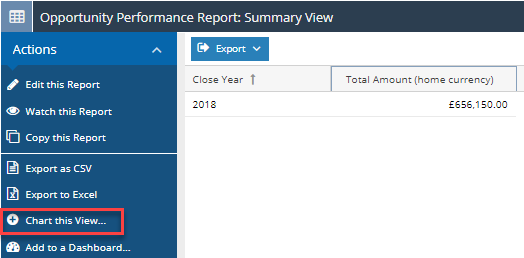
From this window you can select the type of chart you wish to create, to Create a dial chart select the Create a dial chart option.
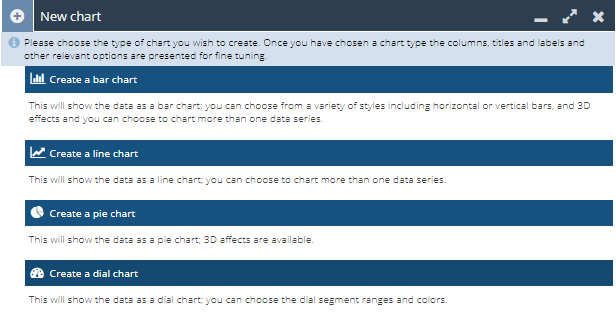
Settings
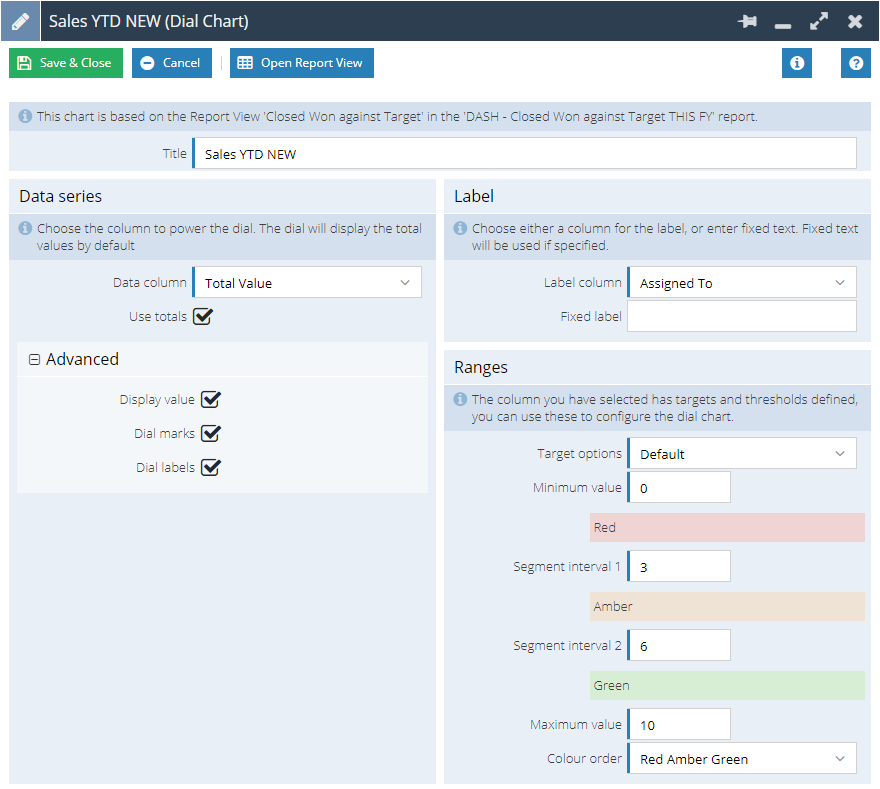
Data Series
Data column – The column from the report that will be used in the chart, this will be a numeric value column.
Use totals – if ticked, the Dial Chart will take the values from the Grand Total row of your report, instead of the report row itself. This means you do not need to create a new Summary View to output the totals.
The below images show the difference, where the first image does not have the ‘Use totals’ box ticked and therefore uses the data from the first row of the report, vs the second where the ‘Use totals’ box is ticked and the chart is using the Grand Total. The first therefore works best if built from a Summary View with a single row for the total.
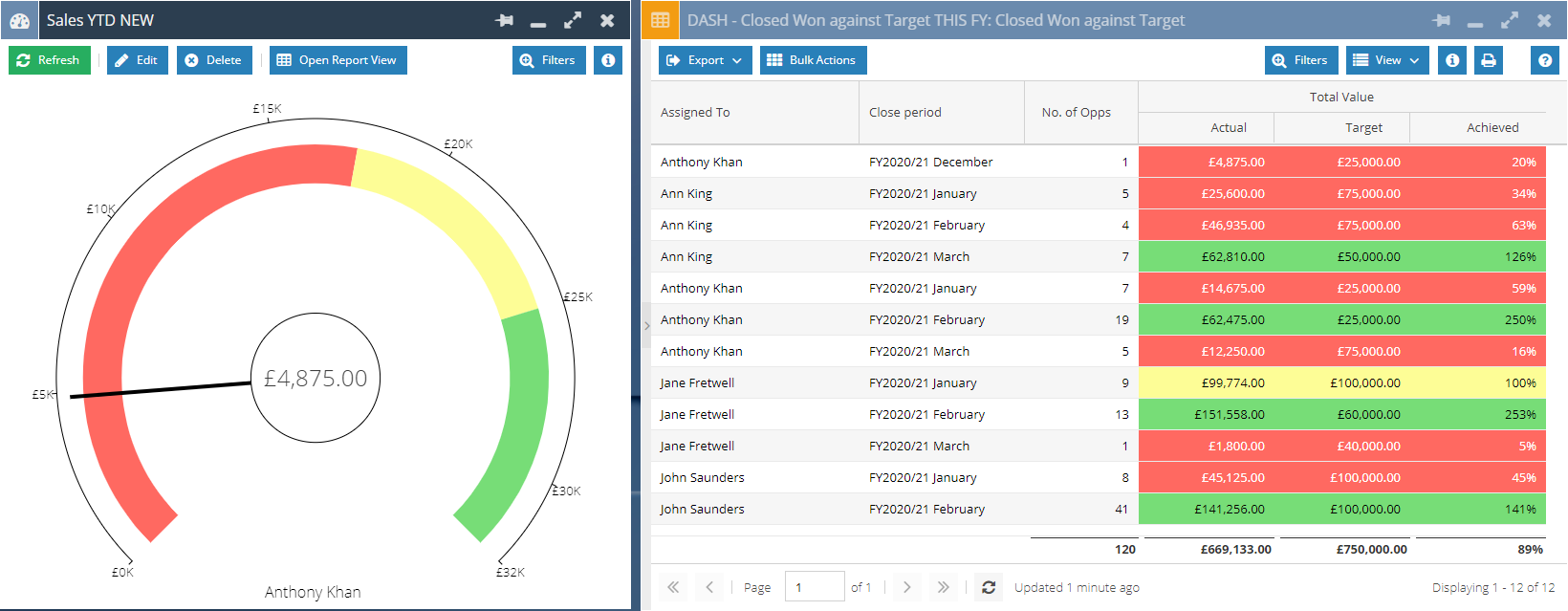
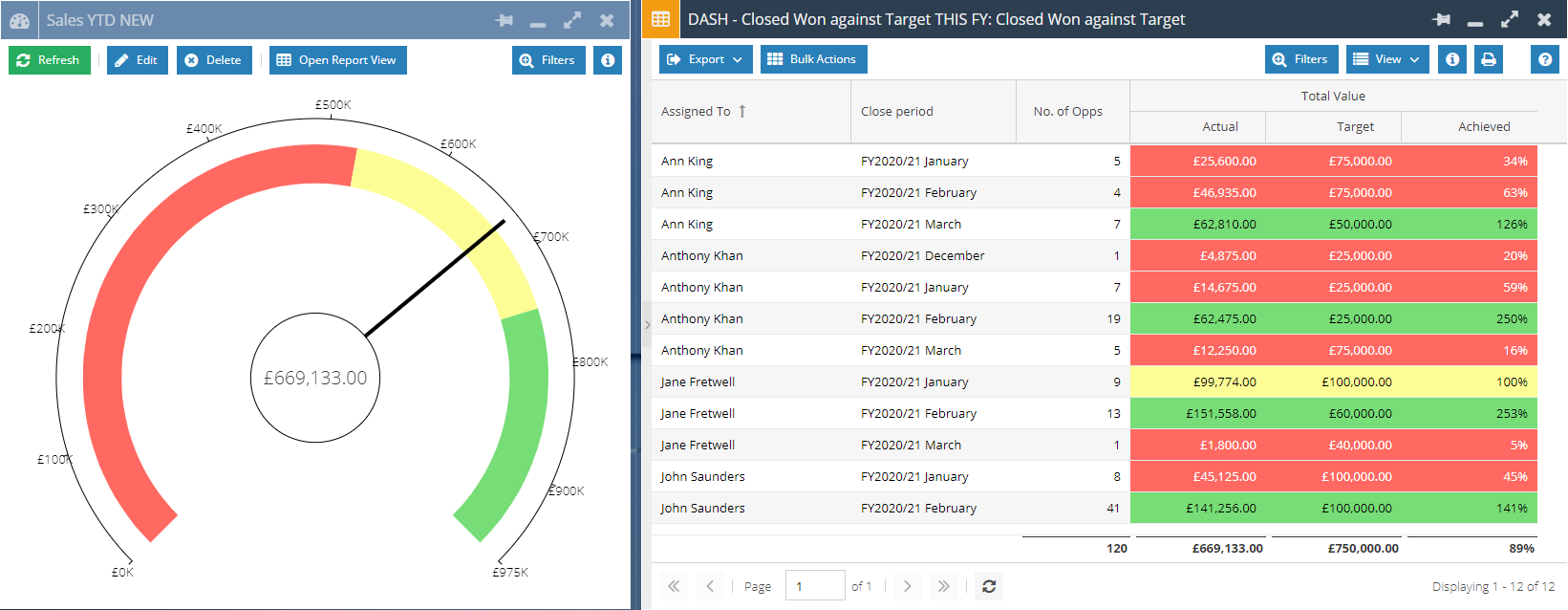
A further benefit to using the ‘Use totals’ setting is that you can then apply filters to the Dial Chart and it will adjust accordingly, as per below. This works well with Dashboard filters.
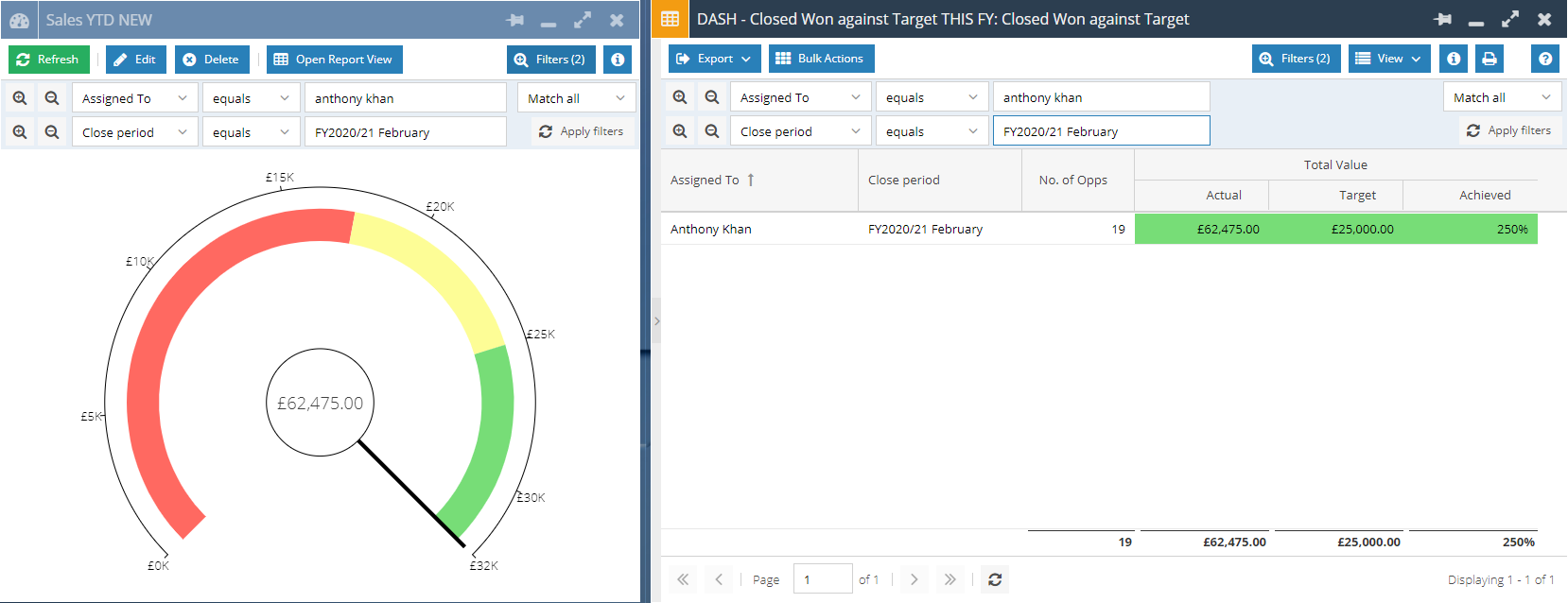
Advanced
Display value – Choose whether you want the value from the report to be displayed in the centre of the dial.
Dial marks – Choose whether marks appear around the edge of the dial.
Dial labels – If ‘Dial marks’ are enabled you are then able to show labels which display the numeric values at each of the marks.
Label
Label column – Choose a column that will be used as the label on the chart, this label is what is used to inform Users of what the dial indicates; this will likely be the same as the ‘Data column’.
Fixed label – If a ‘Fixed label’ is specified it will be used instead of the ‘Label column’ value.
Ranges
Target options – Choose whether you want to manually pick the range of each segment of the dial chart, or whether it should pull them from the targets and thresholds of your report column:
- Default – allows you to manually set the range of each segment of the dial chart, and is fixed to use Red Amber Green as the colours.
- Minimum Value – Select the minimum value of the dial, this is where the dial will start.
- Segment interval – the ‘Segment interval’ values determine when the dial changes from red to amber, amber to green or vice versa.
- Maximum Value – This is the target value that your dial is working towards
- Colour Order – Select whether you want the colours goes Red Amber Green or Green Amber Red depending on how you are using the chart.
- Use targets – allows you to set the range of each segment based on a percentage of the target specified on the Data column, and is fixed to use Red Amber Green as the colours
- Use targets and thresholds – pulls the same ranges and colours specified on the ‘Style’ tab of the Data column.
